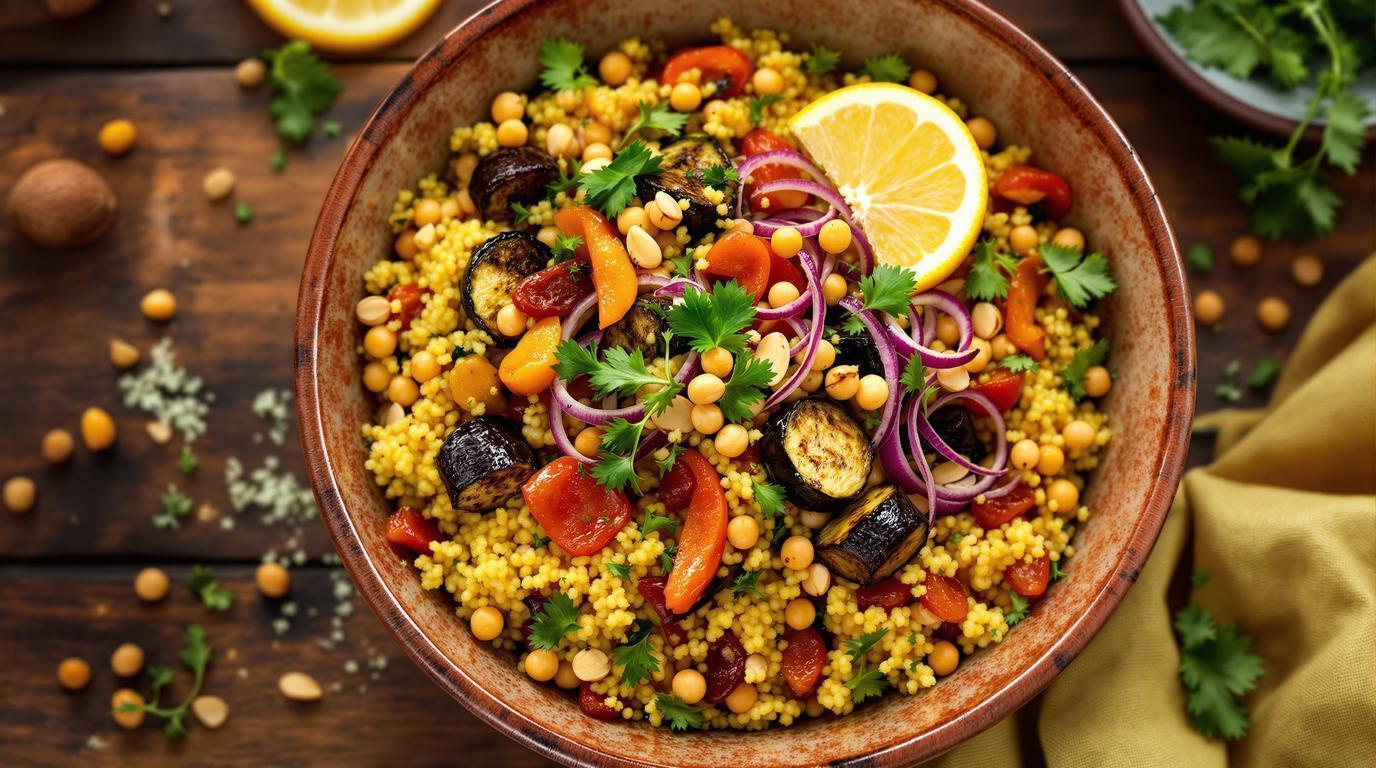There’s something almost magical about Moroccan couscous that takes me back to my first culinary adventure through North Africa. The bustling markets of Marrakech, with their towering spice pyramids and the scent of preserved lemons wafting through narrow alleyways, changed my understanding of what a grain dish could be. Traditional Moroccan couscous isn’t merely a side dish—it’s the centerpiece of celebration and hospitality, often prepared by grandmothers whose hands move with practiced precision developed over decades. The beauty of this dish lies in its deceptive simplicity that yields complex flavors when done properly.
🔥 Traditional Moroccan Couscous Salad with Roasted Vegetables
My version balances authenticity with practical home cooking, transforming a ceremonial dish into an everyday delight without losing its soul. The secret? Properly steamed couscous (never boiled!) combined with vegetables roasted until their natural sugars caramelize, creating layers of flavor that simply can’t be achieved through boiling or sautéing.
The Heart of Moroccan Cuisine 🇲🇦
Traditional couscous preparation involves hours of steaming in specialized couscoussiers, but my method delivers remarkable results in a fraction of the time. The key lies in treating each element with respect—allowing the couscous to properly absorb liquid and steam, and roasting vegetables at high heat to concentrate their flavors.
Chef’s Note: For truly authentic flavor, toast your almonds in a dry pan until fragrant before adding them to the salad. This five-minute step transforms their flavor profile completely, adding a nutty depth that elevates the entire dish.
Essential Ingredients & Preparation 🧾
Begin with quality ingredients. For the couscous base, bring 2 cups of chicken or vegetable broth to a boil with 2 tablespoons olive oil, ½ teaspoon turmeric, and ½ teaspoon salt. Remove from heat, add 1½ cups traditional couscous (never instant), cover, and let steam undisturbed for 5-8 minutes. The discipline to resist lifting the lid is what separates good couscous from exceptional couscous.
While the couscous works its magic, preheat your oven to 450°F (230°C) and prepare your vegetables: 2 red bell peppers cut into strips, 1 small cubed eggplant, 2 sliced zucchini, and 1 thinly sliced red onion. Toss with olive oil, 2 minced garlic cloves, salt and pepper, then spread—without overcrowding—on sheet pans. Overcrowding is the nemesis of proper caramelization; use two pans if necessary.
Roast for 15-20 minutes until the edges begin to darken. This caramelization is where the magic happens—creating complex flavors that make this dish unforgettable. Meanwhile, whisk together your dressing: 4 tablespoons olive oil, 3 tablespoons fresh lemon juice, 1 tablespoon honey, 2 teaspoons of Moroccan spice blend, and harissa to taste.
Assembly & Chef’s Secrets 🤫
Once the couscous has rested, fluff it gently with a fork—never stir with a spoon, which creates clumps. Add ¼ cup raisins directly to the hot couscous and cover again briefly; the residual heat plumps them beautifully. In a large bowl, combine your couscous, roasted vegetables, 1 cup of chickpeas, ½ cup chopped dried apricots, ¼ cup toasted almonds, and fresh herbs.
Pour your dressing over while everything is still slightly warm—this critical step allows the grains to absorb the flavors more effectively. Toss gently, then let the salad rest for 15 minutes before serving. This resting period might test your patience, but it’s essential for flavor development.
Serving & Cultural Context 🍽️
Traditionally, this would be served from a communal dish, eaten by hand from your own “territory” of the platter. For contemporary serving, present in a wide, shallow bowl garnished with additional fresh herbs and lemon wedges. This dish pairs beautifully with a Grilled Halloumi Burger for a complete Mediterranean feast, or alongside Crispy BBQ Cauliflower Bites for a vegetarian spread.
Don’t have dried apricots? Dried peaches or nectarines make excellent substitutions. Can’t find harissa? Start with a pinch of cayenne and adjust to your heat preference. For a complete meal, follow with Grilled Peach Dessert to cleanse the palate.
This salad connects us to centuries of Moroccan culinary tradition while fitting perfectly into our modern lives. Its flavors deepen overnight, making it an ideal make-ahead dish. In my kitchen, I’ve found that food that honors tradition while embracing practicality creates the most memorable experiences—and this couscous salad is living proof that you don’t need to choose between authenticity and convenience. Whether served alongside Mediterranean Chickpea Salad or Corn Rib Magic, it brings the soul of Morocco to your table. Enjoy the journey, one forkful at a time.
